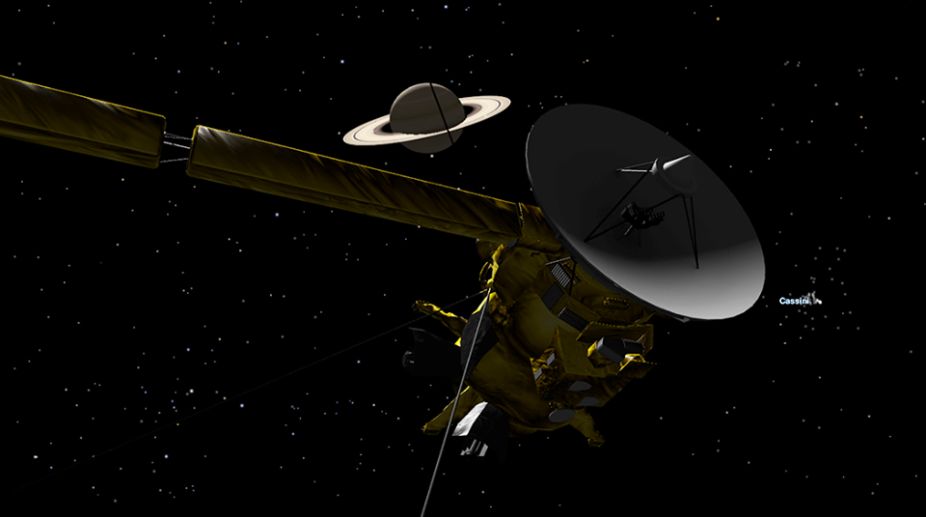Nigar Shaji, Kalpana Kalahasti stand as pioneers in Indian space exploration
Nigar Shaji, the mastermind behind India’s groundbreaking solar mission Aditya L-1, witnessed its triumphant launch on September 2nd from the…

Cassini Saturn Mission (Photo: Facebook)
Cassini will long be remembered as one of the most ambitious and successful space missions ever undertaken. First there was the sheer distance involved. The 22ft long spacecraft, launched from Cape Canaveral, Florida, in 1997, took seven years to reach Saturn after a journey of two billion miles that involved fleeting visits to Venus, Earth and Jupiter.
Each fly-by provided a gravitational “kick” that boosted Cassini’s speed to more than 42,500mph and helped the probe on its way. Another challenge was communicating with and controlling an unmanned robot so far out in the outer solar system.
Saturn is on average 890 million miles from Earth, and it takes around 83 minutes for radio waves to cross that distance at the speed of light. Ground controllers could not give Cassini “real time” instructions and instead relied on extensive pre-programming. Complex sequences of commands were written for large blocks of time lasting hours, days or even weeks, which were encoded in radio signals beamed to the craft. In addition, the probe’s computer “brain” automatically kept it safe and stable and responded to problems requiring immediate action.
Advertisement
That far from the sun, Cassini’s power had to come from a small plutonium-fuelled nuclear reactor rather than the familiar solar panels seen on many space probes. The scientists wanted to get their money’s worth from the £2.9 billion mission and so packed Cassini with instruments, leading to comparisons with a multipurpose Swiss army knife.
Cassini also carried a small lander called Huygens, supplied by the European Space Agency, whose descent to the surface of Saturn’s giant moon Titan made headlines around the world and marked the highpoint of the mission.
In January 2005, the tiny Huygens probe parachuted down through Titan’s thick nitrogen and methane atmosphere and landed on a pebble-strewn surface with the consistency of wet sand. It was the first successful landing made on a world in the outer solar system. The images Huygens sent back showed startling Earth-like features similar to rivers and shorelines.
These and other pictures from orbiting Cassini confirmed that Titan has lakes, rivers and seas filled not with water, but liquid methane and ethane. Cassini carried a total of 12 instruments, several of which were wholly or partly contributed by UK scientists. They provided the probe’s senses for studying the dust, gas and magnetic fields around Saturn and its moons as well as capturing optical and radar images at visible and invisible wavelengths.
Together the instruments delivered a wealth of data that scientists will be analysing for a long time to come. One of Cassini’s chief discoveries was a global watery ocean beneath the icy surface of Saturn’s moon Enceladus. Gravity measurements suggested an ocean some six miles deep below an ice shell 19 to 25 miles thick.
The ocean could explain the appearance of water spray geysers bursting out of fractures at the moon’s South Pole. Scientists believe that, like the similar sub-surface ocean on Jupiter’s moon Europa, the vast reservoir of water under the ice of Enceladus could harbour life.
Cassini also added to Saturn’s large collection of known moons, more than 60 of which have been counted with confirmed orbits. Six named moons were identified by the probe, Methone, Pallene, Polydeuces, Daphnis, Anthe, and Aegaeon.
A seventh unnamed “moonlet” was found embedded in Saturn’s B ring. Cassini’s detailed studies of Saturn’s famous rings, which are made from particles of ice and rocky debris, shed new light on the creation of moons and planets. The probe observed propellerlike formations within the dynamic ring system, and the appearance of a small icy object on the edge of the rings that may mark the birth of a new moon.
In addition, the mission solved the 300-year-old mystery of Saturn’s two-tone moon Iapetus, which has one face that is light and another that is dark. Scientists discovered that as it orbits Saturn, Iapetus picks up dark reddish dust on its leading side.
Water cannot freeze on the darker half of the moon, which absorbs more heat, but forms a bright frosty covering on the lighter hemisphere. Cassini also investigated giant storms on Saturn and spotted raging hurricanes at both poles, and has identified unusual natural radio waves from inside the planet whose origin is still uncertain.
(The independent)
Advertisement